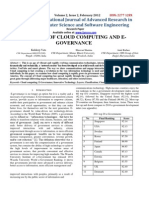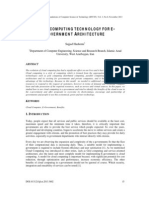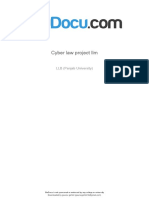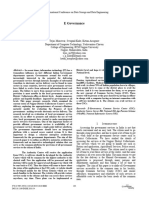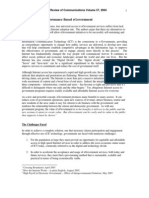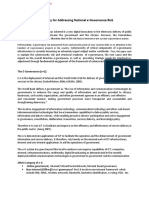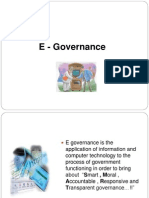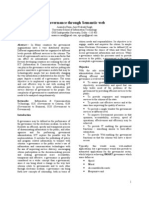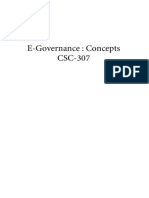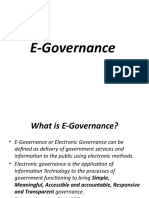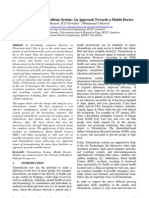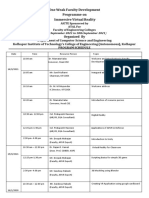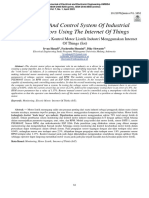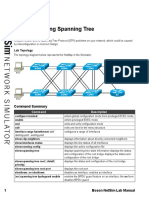Taking Peer-To-Peer Sharing and Collaborative Consumption Onto The Next Level - New Opportunities and Challenges For E-Government
Uploaded by
Freedo ChasinTaking Peer-To-Peer Sharing and Collaborative Consumption Onto The Next Level - New Opportunities and Challenges For E-Government
Uploaded by
Freedo ChasinTAKING PEER-TO-PEER SHARING AND COLLABORATIVE
CONSUMPTION ONTO THE NEXT LEVEL –
NEW OPPORTUNITIES AND CHALLENGES FOR
E-GOVERNMENT
Complete Research
Chasin, Friedrich, University of Muenster - ERCIS, Leonardo-Campus 3, 48149 Muenster,
Germany, friedrich.chasin@ercis.uni-muenster.de
Scholta, Hendrik, University of Muenster - ERCIS, Leonardo-Campus 3, 48149 Muenster,
Germany, hendrik.scholta@ercis.uni-muenster.de
Abstract
Rapid advances in IT combined with increasing awareness for environmental side-effects of modern
economies are causing a shift in the consumer behavior towards new forms of consumption. Private
individuals increasingly become both providers and consumers of services. Web 2.0 enables peer-to-
peer transactions between consumers creating a new consumption space with hundreds of mediator
platforms. While the new legally questionable market is typically seen as a challenge by governments,
the opportunities for governments to participate in peer-to-peer (P2P) sharing and collaborative con-
sumption services (SCCS) for their citizens are hardly explored in academia. In contrast, first pioneer
governments such as the cities of Seoul and San Francisco have already developed strategies to sup-
port the development of P2P SCCS for their citizens. In this work, we advocate for extending the func-
tion scope of e-government by including P2P SCCS into its portfolio. To support our reasoning and in
order to systematically address the problem area emerging from the combination of e-government and
P2P SCCS, we review and synthesize e-government models and relate them to the P2P SCCS phenom-
enon. Our results reveal what constitutes a research agenda for utilizing potentials of P2P SCCS in
the context of e-government research and practice.
Keywords: E-Government, Peer-to-Peer Sharing, Sharing Services, Collaborative Consumption.
1 An Ignored Potential
Following the initial, mostly positive, hype around the emergence of IT-enabled peer-to-peer (P2P)
sharing and collaborative consumption services (SCCS) (Geron, 2013; The Economist, 2013) in the
markets such as food (LeftoverSwap), accommodation (Airbnb), transport (Uber) and clothes (Share
Closet), a countermovement is emerging, in which not only the competitors from the traditional busi-
nesses (Owyang et al., 2013), but also governments raise concerns regarding the legitimacy of peer-to-
peer practices (Chernova, 2013; Tuttle, 2013; Wogan, 2013). Main criticism is concentrated around
missing regulations for new consumption space, where services are offered by private individuals and
often lack regulations that are typical for traditional businesses. A private taxi is for example missing
regulations forced upon the enterprise taxi (Cellan-Jones, 2014), a private host does not comply with
regulations circulating the hotel industry (Vasagar, 2014) and a kindergarten offered by a group of
private individuals is far from achieving the formal standards required from the public ones (Wogan,
2013).
Twenty-Third European Conference on Information Systems (ECIS), Münster, Germany, 2015
Chasin and Scholta / Peer-to-Peer Sharing and E-Government
Nevertheless, the motivations behind P2P SCCS are aligned with the aims of each government. If the
purpose of a government is “to meet the needs of its constituency, to maintain their welfare […] serv-
ing people’s basic needs, both physical and economic” (Firestone and Catlett, 2009, p. 296), then al-
lowing its citizens to solve economic, social and environmental challenges of today by means of P2P
SCCS is an aim worth striving for. Both in academic (Botsman and Rogers, 2011; Heinrichs and
Grunenberg, 2013) and public (Geron, 2013; The Economist, 2013) discourse, P2P SCCS are dis-
cussed as a promising instrument to address these challenges. In fact, some governments already ac-
tively support the development of sharing and collaborative consumption. However, a mere support is
arguably not enough to unfold the potential of P2P SCCS for solving challenges such as overpopula-
tion and resource overcapacity (Princen et al., 2002).
There is a hidden potential for electronic government (e-government) to assume functions in peer-to-
peer sharing and collaborative consumption services. The benefits of an active participation by gov-
ernments in P2P SCCS are manifold. First, since trust is a major impediment for establishing P2P
SCCS networks (Botsman and Rogers, 2011; Petri et al., 2011), a mediation by a trusted stakeholder
such as a local government can spur the citizens’ involvement in the P2P practicing. Second, the pro-
vision of a platform for P2P SCCS can utilize already existing e-government infrastructure therefore
minimizing investments required to establish the services. Third, by taking the mediator role, govern-
ments can exercise greater control over the P2P practicing therefore addressing critical issues that are
on the current agenda of governments when it comes to problems in regard to missing regulations in
the P2P SCCS market. Finally, a number of sharing and collaborative consumption services cannot
exist in the realm of commercial business models. Sharing and exchange of cheap yet resource-
consuming assets often cannot be combined with attractive revenue models for an entrepreneur inter-
ested in providing a platform for P2P SCCS (Belk, 2007, 2010). The corresponding market can be
however created by a governmental body through publically funded e-government services.
We conclude from the above that there are sound reasons and a not yet realized potential for e-
government to actively support the establishment of IT-based services, which would enable citizens to
address their needs through peer-to-peer sharing and collaborative consumption of resources. Specifi-
cally, we address the following research goal: Integrating P2P SCCS into classical e-government
models and providing a meaningful research agenda for integrating the provision of IT-enabled peer-
to-peer sharing and collaborative consumption services into the scope of e-government.
To derive a meaningful research agenda, we structure our work as follows. First, we provide theoreti-
cal background in regard to both e-government and P2P SCC services. We then describe our approach
for deriving e-government models that enable the integration of P2P SCCS. Afterwards, we present
these e-government models which have been used to derive the research agenda. In our result section,
we integrate P2P SCCS into the e-government models and discuss the corresponding research agenda
for utilizing potentials of P2P SCCS in the context of e-government.
2 Research Background
2.1 Sharing and Collaborative Consumption Services
IT-enabled P2P SCCS belong to consumer practices, in which the owner of the resource is a private
individual (Andersson et al., 2013; Petri et al., 2010). In P2P SCCS, access to a resource is preferred
over the ownership and a function of the consumption object over the product that enables this func-
tion (Bardhi and Eckhardt, 2012; Chen, 2009; Tencati and Zsolnai, 2012). This type of alternative
consumer practices goes by names such as collaborative consumption (Botsman and Rogers, 2011),
access-based consumption (Bardhi and Eckhardt, 2012), the mesh (Gansky, 2010) or product-service
systems (Mont, 2002) and are often subsumed under the term of sharing economy (Heinrichs and
Grunenberg, 2013; Kassan and Orsi, 2012; Malhotra and Van Alstyne, 2014).
Different and often incompatible definitions of sharing and collaborative consumption exist in the
public and academic discourse (Belk, 2014a; Benkler, 2004; John, 2013; Wittel, 2011). However,
Twenty-Third European Conference on Information Systems (ECIS), Münster, Germany, 2015 1
Chasin and Scholta / Peer-to-Peer Sharing and E-Government
sharing and collaborative consumption can be seen as subsets of the access-based consumption
(Bardhi and Eckhardt, 2012). Both phenomena are similar in that they represent a shift in consumer
behavior towards alternative forms of consumption. The motivations for this shift range from the pro-
spects of economic benefits (Bardhi and Eckhardt, 2012) to ethical concerns regarding overconsump-
tion (Belk, 2014a; Leismann et al., 2013), prospects of environmentally-driven resource utilization
(Elliot, 2011; Malhotra et al., 2013) and addressing degradation of the natural environment (Anderegg
et al., 2010; Oreskes, 2004). Despite the similarities, sharing and collaborative consumption are, how-
ever, different in regard to whether the provision of access to a privately owned resource is followed
by some form of compensation or not. Sharing forms a qualitative relationship between involved indi-
viduals and does not involve money (Belk, 2007, 2010). Hence, it is different from pseudo-sharing
(Belk, 2014b) such as traditional car sharing, which typically involves a monetary compensation for
the provided mobility service. On the other hand, collaborative consumption forms a quantitative rela-
tionship between participants through monetary or any other quantitative compensations (Bardhi and
Eckhardt, 2012; Belk, 2014a).
The Information Systems research has not yet systematically addressed the phenomenon of P2P SCCS
in combination with tangible goods. While there is a significant body of research on the sharing of
digital goods (Bergquist and Ljungberg, 2001; Hughes et al., 2005; Nunes and Correia, 2013; Xia et
al., 2012), the research is silent in regard to the specifics of sharing and collaborative consumption of
tangible assets. This is especially true for its peer-to-peer-based subset (Andersson et al., 2013).
2.2 E-Government and its Relation to P2P SCCS
E-government is “the simplified handling of information, communication and transaction processes for
providing an administrative service through the use of information and communication technologies
within and between authorities, and between authorities and private individuals or companies” (Becker
et al., 2012 p. 21). Classical e-government services comprise among others the publication of infor-
mation on governmental websites, answering questions via e-mail and the processing of applications
and requests. However, there are concepts which aim at an active involvement of citizens in govern-
mental processes. In the course of co-production, citizens not only consume but also assist in produc-
ing government services (Meijer, 2011; Needham, 2008; Whitaker, 1980). E-participation aims at
integrating citizens in administrative and political decision making, i.e. enables citizens to design gov-
ernments (Macintosh, 2004; Sæbø et al., 2008; Sanford and Rose, 2007).
Although these topics to involve citizens in processes of public administrations have been targeted by
researchers comprehensively, P2P SCCS has yet not been connected to e-government. At the same
time, first public administrations around the globe begin to actively support the development of P2P
SCCS for their citizens. The city of Chicago enables to share winter resources among the citizens
(City of Chicago, 2014). In Seoul, the government started a city-funded multifaceted project to support
the introduction of P2P SCCS (Johnson, 2013). And the city of San Francisco actively supports the
growing P2P SCCS market (Stoll, 2012). LINDERS (2012) defines the term Do it Yourself Government
to describe scenarios where public administrations do not take an active role and enable citizen-to-
citizen coproduction by offering a supporting platform or framework. BOTERO ET AL. (2012) provide a
collection of articles presenting experiences from Finland regarding peer-to-peer sharing in public
services. To the best of our knowledge, sharing services as new kind of participatory e-government
services have not been targeted from a scientific perspective in detail. This paper extends the scope of
e-government research to P2P SCCS.
3 Research Design
The aim of this work is to provide a meaningful research agenda for integrating the provision of IT-
enabled peer-to-peer sharing and collaborative consumption services into the scope of e-government.
In the course of traditional e-government services, the government takes the role of the provider and
the citizen the role of a consumer. In the P2P SCCS setting the role of the government in e-
Twenty-Third European Conference on Information Systems (ECIS), Münster, Germany, 2015 2
Chasin and Scholta / Peer-to-Peer Sharing and E-Government
government services is shifting towards representing an intermediary for citizens being both users and
providers of resources. To integrate P2P SCCS into the range of e-government services, we therefore
require extended conceptualizations of e-government. For this purpose, we synthesize various models
describing the functions and scope of e-government from different perspectives, before incorporating
P2P SCCS aspects into them. The derived models represent the state-of-the-art in regard to e-
government concepts. They therefore help to identify aspects of e-government that require changes in
order to include P2P SCCS as an e-government service. Our methodological process is illustrated in
Fig. 1. Based on WEBSTER AND WATSON (2002) and VOM BROCKE ET AL. (2009), the first step is to
search for a representative set of models that conceptualize the scope and the functions of e-
government (Step 1 in Fig. 1). Combinations of keywords such as e-government, reference, frame,
framework, model and synthesis as well as the search engines Scopus, Web of Science and Google
Scholar have been used to search for relevant articles. Additionally, backward and forward searches
have been performed. Subsequently, identified models are grouped according to the type of aspect
these e-government models cover. By discussing similarities and differences among the models in
each of the categories, the aim is to derive what constitutes a corresponding synthesized model for
each of the categories (2). The number of synthesized models is not determined in advance. Instead,
the grouping of similar models that were identified during the literature review determines the final
amount of synthesized models. The synthesized models are then extended to integrate P2P SCCS and
their specific characteristics in the third step (3). Finally, we use the extended synthesized models of e-
government to derive and to formulate a research agenda for utilizing potentials of P2P SCCS in the
context of e-government.
E-Government Research
1
E-Gov. …
Models
2
Synthesized …
Models
P2P Sharing and Collaborative Consumption as E-Government Services
3
Adapted • RQ1 • RQ • RQ
Models • RQ • RQ • RQn
• … • … • …
Models that take account for implications imposed by P2P SCCS as part of e-government
Figure 1. Methodological Steps
4 Synthesized E-Government Models
After searching for models according to step one of the chosen methodology, the total of 30 relevant
models were identified and grouped into three relevant categories of e-government models. The first
group of models describes stakeholders of e-government services, the second visualizes acceptance
factors and the third considers stages.
4.1 Synthesized Stakeholder Model
The first group of models considers different stakeholders (Freeman, 1984) of e-government services.
Since e-government services are used by governments to interact with different entities, stakeholder
models are suitable means in order to illustrate the involved parties and are widely conceptualized and
applied in literature (Affisco and Soliman, 2006; Becker et al., 2012; Belanger and Hiller, 2006;
Twenty-Third European Conference on Information Systems (ECIS), Münster, Germany, 2015 3
Chasin and Scholta / Peer-to-Peer Sharing and E-Government
Beynon-Davies, 2007; Brown and Brudney, 2001; Coursey and Norris, 2008; Fang, 2002; McClure,
2001; Scholl and Klischewski, 2007; Siau and Long, 2005; Yildiz, 2007). Abstracting from different
terminologies, five stakeholders have been identified.
The first stakeholder is the government which communicates with other entities and delivers services
to them. One receiver of governmental services is the citizen, also named customer. Both terms are
used interchangeable. Consequently, the relationship between the government and its citizens or cus-
tomers is named Government-to-Customer or Government-to-Citizen (G2C) 1. Accordingly, govern-
ments can deliver services to businesses which are named Government-to-Business (G2B) services 2.
These two kinds of relations may be further subdivided into GwIS (Government with individuals –
delivering services), GwIP (Government with individuals – political process), GwBC (Government
with business as a citizen) and GwBMKT (Government with business in the marketplace) (Belanger
and Hiller, 2006). In order to provide citizens and companies with services, the cooperation between
governments might be necessary. The relationship between governments themselves is called Gov-
ernment-to-Government (G2G) 3. Finally, governments interact with their employees which is named
Government-to-Employee (G2E) 4. Alternatively, this communication may be subsumed by G2G
(Affisco and Soliman, 2006). The synthesized stakeholder model is visualized in Fig. 2. Citizen-to-
Citizen (C2C) communication may also be seen as part of a stakeholder model if it enables and pro-
motes the usage of IT in governments (Beynon-Davies, 2007) or deals with governmental services
(Yildiz, 2007). However, C2C is not integrated into our model since in the above mentioned C2C sce-
narios the government is not directly involved in the communication. Instead, it is topic of a conversa-
tion (C2C communication deals with governmental services) or an entity that may be influenced by
C2C interaction (C2C promotes the usage of IT in governments). Other relations such as Government-
to-Nonprofit (G2N) (Fang, 2002) and Government-to-Civil Society Organizations (G2SC) (Yildiz,
2007) are not incorporated into the model due to their rare occurrences and low relevance for the inte-
gration of P2P SCCS.
Government Employee
G2G G2E
Government
G2C G2B
Citizen Business
Figure 2. Synthesized Stakeholder Model
4.2 Synthesized Acceptance Factors
Besides numerous stakeholder models for e-government, a large number of models exist explaining
acceptance factors for the usage of e-government services (Bhattacherjee and Sanford, 2006; Carter
and Bélanger, 2005; Hofmann et al., 2012; Huang, 2007; Korteland and Bekkers, 2008; Lin et al.,
2011; Ozkan and Kanat, 2011; Shareef et al., 2011; Yao and Murphy, 2007). Different theories are
1For reading convenience, the references are annotated as footnotes: (Affisco and Soliman, 2006; Becker et al., 2012;
Beynon-Davies, 2007; Brown and Brudney, 2001; Coursey and Norris, 2008; Fang, 2002; McClure, 2001; Scholl and
Klischewski, 2007; Siau and Long, 2005; Yildiz, 2007)
2(Affisco and Soliman, 2006; Becker et al., 2012; Beynon-Davies, 2007; Brown and Brudney, 2001; Coursey and Norris,
2008; Fang, 2002; McClure, 2001; Scholl and Klischewski, 2007; Siau and Long, 2005; Yildiz, 2007)
3(Affisco and Soliman, 2006; Becker et al., 2012; Belanger and Hiller, 2006; Beynon-Davies, 2007; Brown and Brudney,
2001; Coursey and Norris, 2008; Fang, 2002; McClure, 2001; Scholl and Klischewski, 2007; Siau and Long, 2005; Yildiz,
2007)
4 (Belanger and Hiller, 2006; Fang, 2002; McClure, 2001; Scholl and Klischewski, 2007; Siau and Long, 2005)
Twenty-Third European Conference on Information Systems (ECIS), Münster, Germany, 2015 4
Chasin and Scholta / Peer-to-Peer Sharing and E-Government
used to arrange a multitude of acceptance factors in the models. Studies in this context are predomi-
nantly quantitative studies in which psychometric questionnaires are used to capture respondents’ atti-
tude and intention to use e-government services. The majority of the models makes use of the Tech-
nology Acceptance Model (TAM) (Davis et al., 1989) and its extensions for e-government 5. Further
models and theories considered to arrange e-government acceptance factors include for instance the
Theory of Planned Behavior (TPB) (Ajzen, 1991) found in a number of studies 6 and the Diffusion of
Innovation (DOI) (Rogers, 1995) theory 7. Against the backdrop of multiple theories used as a theoreti-
cal lens to explain and predict user acceptance of e-government services, a synthesis of these hetero-
geneous models is not meaningful. However, different acceptance factors can be grouped into catego-
ries providing an overview of acceptance factors identified in research. Since this paper focuses on
P2P SCCS with governments as intermediaries, acceptance factors of citizens as users and govern-
ments are relevant. Acceptance factors of businesses are out of scope.
Among the identified works concerning the identification of e-government acceptance factors, one
work by HOFMANN ET AL. builds a taxonomy of relevant factors (Hofmann et al., 2012). Fig. 3 visual-
izes the categories of impact factors proposed by HOFMANN ET AL. The acceptance of e-government is
influenced by government characteristics such as its organizational size (Korteland and Bekkers,
2008). Besides, regional and population characteristics like the diversity of ethnic structures and the
population growth are influential (Huang, 2007). Other significant categories are managerial charac-
teristics, government capacities and environmental characteristics. On the citizen side, technology
characteristics such as perceived ease of use (Carter and Bélanger, 2005; Lin et al., 2011; Ozkan and
Kanat, 2011; Yao and Murphy, 2007) or perceived ability to use (Shareef et al., 2011) are important.
Additionally, trust (Carter and Bélanger, 2005; Ozkan and Kanat, 2011; Shareef et al., 2011) and fac-
tors of the other categories environmental characteristics, service characteristics and user characteris-
tics influence citizens’ acceptance of e-government services.
For Governments:
For Citizens:
• Regional and Population
Characteristics • Technology Characteristics
• Government Acceptance of • Environmental
Characteristics E-Government Characteristics
• Managerial Characteristics Services • Service Characteristics
• Government Capacities • User Characteristics
• Environmental • Trust
Characteristics
Figure 3. Synthesized Acceptance Factors for E-Government
4.3 Synthesized Stage Model
Besides stakeholders and acceptance factors, stages have been identified as third main category. Stag-
es indicate the maturity and comprehensiveness of e-government services. Models and classifications
regarding maturity stages of e-government services are widely used in literature (Affisco and Soliman,
2006; Andersen and Henriksen, 2006; Becker et al., 2012; Brown and Brudney, 2001; Fang, 2002;
Hiller and Bélanger, 2001; Klievink and Janssen, 2009; Layne and Lee, 2001; Lee, 2010; Siau and
Long, 2005). These models have a varying quantity of stages and the individual stages may have dif-
ferent semantics. The names of the phases have slightly been aggregated in comparison to the sources,
for instance “Transaction” and “transacting” both refer to “Transaction”. The first phase called Cata-
logue (Layne and Lee, 2001), Web Presence (Siau and Long, 2005), Publishing (Affisco and Soliman,
5 (Bhattacherjee and Sanford, 2006; Carter and Bélanger, 2005; Lin et al., 2011; Shareef et al., 2011; Yao and Murphy, 2007)
6 (Bhattacherjee and Sanford, 2006; Ozkan and Kanat, 2011; Shareef et al., 2011)
7 (Bhattacherjee and Sanford, 2006; Huang, 2007; Shareef et al., 2011)
Twenty-Third European Conference on Information Systems (ECIS), Münster, Germany, 2015 5
Chasin and Scholta / Peer-to-Peer Sharing and E-Government
2006) or Information 8 describes the publication of information. Secondly, Interaction 9 or Communica-
tion 10 represents the offering of communication channels by governments. The third stage comprises
the offering to perform self-services online. Hence, it is named Transaction 11. The next stage repre-
sents the provision of seamless and integrated e-government services, i.e. changes the way govern-
ments offer services which leads to the names Integration 12 and Transformation 13. Finally, the fifth
stage enables the participation and involvement of citizens in the decision making process. The stage
is named E-Democracy (Siau and Long, 2005), Democratic Transactions (Brown and Brudney, 2001)
or Participation (Hiller and Bélanger, 2001). Additionally, there are models whose stages cannot be
combined with the stages of the other models since they conceptualize stages from different perspec-
tives 14.
Stages can be characterized by dimensions: Integration and Technological and Organizational Com-
plexity (Layne and Lee, 2001), Customer centric and Activity centric applications (Andersen and
Henriksen, 2006), Level of flexibility and Level of customer orientation (Klievink and Janssen, 2009)
as well as Time/Complexity/Integration and Benefits/Costs (Siau and Long, 2005). During the model
synthesis phase, we have identified the model by LEE (2010) which covers the majority of aspects
identified in the aforementioned stage models. Therefore, the synthetized model in Fig. 4 borrows
terminology from LEE’S stage model.
Involvement
Citizen/ Service
Participation
Transaction Presenting
Very High
Very Low
Medium
Interaction
High
Low
Presenting Assimilating
Government
Cost Reforming
Services
Presenting
Morphing
Technology
Operation/
Integration
Streamlining e-Governance
Transformation
Process Mgmt.
Figure 4. Synthesized Stage Model based on (Lee, 2010)
The model by LEE suggests five stages of e-government characterized by two perspectives opera-
tion/technology and citizen/service (Lee, 2010). The first stage is named Presenting. Secondly, the
Assimilating stage covers the composition of different information technologies in order to enable a
two-way-communication. An interaction with citizens requires the technological integration of infor-
8 (Becker et al., 2012; Brown and Brudney, 2001; Fang, 2002; Hiller and Bélanger, 2001)
9 (Affisco and Soliman, 2006; Siau and Long, 2005)
10 (Becker et al., 2012; Brown and Brudney, 2001; Fang, 2002; Hiller and Bélanger, 2001)
11(Affisco and Soliman, 2006; Becker et al., 2012; Brown and Brudney, 2001; Fang, 2002; Hiller and Bélanger, 2001; Layne
and Lee, 2001; Siau and Long, 2005)
12 (Hiller and Bélanger, 2001; Layne and Lee, 2001)
13 (Affisco and Soliman, 2006; Siau and Long, 2005)
14 (Andersen and Henriksen, 2006; Klievink and Janssen, 2009)
Twenty-Third European Conference on Information Systems (ECIS), Münster, Germany, 2015 6
Chasin and Scholta / Peer-to-Peer Sharing and E-Government
mation system elements. The third stage is named Reforming which means the improvement of gov-
ernmental real-world processes using requirements and benefits of information technology leading to
higher efficiency. Regarding the operational perspective this requires the streamlining and enhance-
ment of real-world processes. On the citizen side this leads to enabling transactional electronic ser-
vices. The Morphing stage describes the shaping of governmental appearances and processes within
the real world and the information space by extending the governmental scope. After the reformation
and automation of classical governmental services such as application processing in the course of the
prior stage, this phase leads to a transformation of the governmental profile since new services may
evolve previously unknown to governments. Regarding the citizen perspective this results in participa-
tion. Finally, the e-Governance stage describes a visionary scenario where the virtual space and the
real world are administrated synchronously in almost real time. Citizens are involved in governmental
and political decision processes.
In addition to the dimensions proposed by LEE, we add the Cost dimension to the model since it is
important for e-government services as well as the integration of P2P SCCS and is not covered by the
model yet. In this case, costs are meant as monetary amount to establish and maintain an e-government
service. This comprises among others costs for employees to set up the technical infrastructure and
support the citizens in using the service. The more mature a stage is, the higher the costs for govern-
ments to provide according services are. For example, presenting information on a website requires
less resources and costs than offering elections via the internet in order to achieve a higher citizen
involvement.
5 P2P Sharing as an E-Government Service – The Research
Agenda
We divide the research agenda in accordance with three basic e-government models that were synthe-
sized in the previous section. For each model, we indicate extensions that are required to represent the
extended scope of e-government, which would include P2P SCCS into the range of services supported
by e-government. In the following, we focus on each of the synthesized models to derive research
questions resulting from the models’ extensions that are required to include P2P SCCS. Finally, we
put the single research questions into perspective and outline the research agenda.
5.1 Research Questions Associated with the Stakeholder Model
In order to include the provision of P2P SCCS into the scope of e-government services, the stakehold-
er model is adapted as illustrated in Fig. 5. Since a government can provide a platform for allowing
peer-to-peer sharing and collaborative consumption of resources for its citizens, an additional ‘citizen’
stakeholder is included to represent a possible citizen-to-government-to-citizen (C2G2C) relationship
with the government as intermediary.
Government Employee
G2G
G2E
G2C
Government
Citizen G2B
P2P
SCCS
Business
G2C
Citizen
Figure 5. Synthesized and Adapted Stakeholder Model
Twenty-Third European Conference on Information Systems (ECIS), Münster, Germany, 2015 7
Chasin and Scholta / Peer-to-Peer Sharing and E-Government
The following table summarizes research questions resulting from the integration of P2P SCCS into
the stakeholder model of e-government (Tab. 1).
RQ1: How can a government participate in establishing a P2P SCCS platform as an e-government service for
its citizens?
Alternatives can range from sponsoring and advertising to developing and operating the platform by itself.
The research question results from the evaluation of the synthesized and adapted stakeholder model. Govern-
ments can take different roles in relationships with the other stakeholders (citizens, businesses, employees and
other governments). These alternatives need to be evaluated in a dedicated research as they are manifold. For
instance, governments could assume a novel role of the intermediary between citizens by providing a digital
platform where citizens can share and collaboratively consume their resource. On the other hand, governments
can limit their participation in P2P SCCS through offering public resources on existing P2P SCCS platforms
or even limiting it to a mere sponsoring. Between these two extremes there is a space of alternatives that need
to be explored by answering the proposed research question.
RQ2: Which form of participation in establishing a P2P SCCS platform as an e-government service is suitable
for which government?
While for some governments any form of participation can be difficult, others should satisfy prerequisites
associated with a certain form of participation. Similarly to RQ1, this research question results from the exam-
ination of the stakeholder model. It is not only important to answer the question of which roles can be taken
by the government. The identified participation alternatives should be mapped and evaluated in regard to
concrete contexts. The choice of a suitable role depends on a multiplicity of factors that need to be first identi-
fied and then set in relation to the participation alternatives. Ideally, a set of evaluation techniques is devel-
oped that would help a government to, first decide whether a participation in P2P SCCS is meaningful in the
concreate case and second to choose a suitable role for the participation in P2P SCCS.
RQ3: What are external obstacles and barriers for the introduction of P2P SCCS as an e-government service
and how can they be addressed?
External factors such as the legal environment can prevent or impede certain forms of governments’ participa-
tion in establishing P2P SCCS. This research question results from the analysis of the relationships in the
stakeholder model. Each relationship, represented by an arrow between the government and the corresponding
stakeholder (cf. Fig. 5), is subject to an analysis for potential barriers such as legal challenges that can hinder
the relationship. It is therefore required to address the proposed research question and to systematically ad-
dress each relationship of the synthesized stakeholder model in regard to potential external obstacles and bar-
riers for the introduction of P2P SCCS as an e-government service.
RQ4: How does the participation of a government in establishing P2P SCCS affect its relationships to other
e-government stakeholders?
The decision of a government to participate in P2P SCCS affects the relationships not only to those stakehold-
ers that become involved in the establishment of corresponding P2P SCCS, but also to those stakeholders that
observe a change in the government’s role. For example, a decision to establish a relationship with a business
(G2B) by allowing businesses to provide resources on the government’s P2P SCCS platform can have dra-
matic effects on the relationship of the government at hand to its citizens (G2C) and to other governments
(G2G). Hence, it is important to investigate in which way the interdependent relationships illustrated in the
synthesized and adopted stakeholder model are influenced by the government’s decision to participate in P2P
SCCS. Studies of governments that have pioneered the P2P SCCS domain such as the cities of Seoul and San
Francisco can help to answer the research question.
Table 1. Research Questions based on the Stakeholder Model
5.2 Research Questions Associated with Acceptance Factors
The introduction of P2P SCCS as an e-government service has several implications from the perspec-
tive of acceptance factors that are relevant for e-government (Fig. 6). First, in addition to acceptance
factors for providing an e-government service, another set of acceptance factors is relevant in case
Twenty-Third European Conference on Information Systems (ECIS), Münster, Germany, 2015 8
Chasin and Scholta / Peer-to-Peer Sharing and E-Government
when governments decide to whether offer resources over the platform in addition to providing or
supporting the platform. Second, since each citizen can provide a resource, corresponding acceptance
factors need to be distinguished from those relevant for the decision to either use the resources offered
through the platform or not. In order to include the provision of P2P SCCS into the scope of e-
government services, the figure on acceptance factors needs to be adapted.
Participating in P2P SCCS Providing P2P SCCS
Providing P2P SCCS Platform Using P2P SCCS
For Governments: For Citizens:
Acceptance of
• Regional and Population E-Government • Technology Characteristics
Characteristics Services • Environmental
• Government Characteristics Characteristics
• Managerial Characteristics • Service Characteristics
• Government Capacities • User Characteristics
• Environmental • Trust
Characteristics
Figure 6. Synthesized and Adapted Acceptance Factors
The following table summarizes research questions resulting from the integration of P2P SCCS into
the scope of e-government with regard to acceptance factors (Tab. 2).
RQ5: What is the antecedent structure for the governments’ acceptance in regard to establishing P2P SCCS
as an e-government service?
The adapted figure on acceptance factors for e-government services comprises four parts, each of which needs
to be addressed (cf. Fig. 6). Similarly to the question of how the introduction of traditional e-government
services can be hindered or facilitated depending on the varying degree of acceptance by the government
itself, the acceptance of P2P SCCS within governments needs to be investigated. Consequently, we need to
understand the acceptance factors of the decision makers in the governments that are critical for the introduc-
tion of P2P SCCS as e-government service. Researchers that aim at understanding the antecedents of ac-
ceptance in the context of P2P SCCS as e-government service can build upon the mature body of knowledge
in regard to the acceptance of traditional e-government services. To answer the question is crucial for the
integration of P2P SCCS into the scope of e-government because the integration cannot be undertaken if deci-
sion makers in the governments do not accept the services.
RQ6: How can an incentive structure support the governments’ attitude towards P2P SCCS as an e-
government service?
Insights from answering RQ5 can be utilized to study the possible incentive structures that can positively
influence the governments’ attitude towards P2P SCCS. The identification of effective incentives can be uti-
lized to foster a successful introduction of P2P SCCS as an e-government service. Although the research ques-
tion does not result directly from the adapted figure on acceptance factors, it builds directly upon the research
question RQ5. To answer the question, similar problem areas can be studied such as, for example, the studies
of other non-profit organizations in regard to possible incentives that can be used to influence the attitude of
decision makers towards new technologies and services.
RQ7: To what extent can citizens’ trust in IT-enabled P2P SCCS be improved through governments assuming
the role of the platform provider?
Trust is known to be a crucial aspect for the participation in P2P SCCS (Botsman and Rogers, 2011). It is
however yet unclear whether citizens’ trust can be increased with the government assuming the role of the
intermediary. It is reasonable to assume that governments are previewed as more trustworthy by the citizens
than profit-oriented companies. On the other hand, recent data protection affairs have had negative impact on
citizens’ trust in governments. The answer to the research question is therefore required before any attempts
by governments to introduce P2P SCCS are initiated.
Twenty-Third European Conference on Information Systems (ECIS), Münster, Germany, 2015 9
Chasin and Scholta / Peer-to-Peer Sharing and E-Government
RQ8: How do the antecedents of acceptance in regard to providing and using P2P SCCS as an e-government
service differ from the citizen perspective?
A successful operation of a P2P SCCS platform is only possible when services are both used and provided. As
illustrated in the synthesized and adopted figure on acceptance factors, in the context of P2P SCCS, the ques-
tion of the citizens’ acceptance of the services is twofold. Since citizens can not only use services in the con-
text of P2P SCCS but also assume the role of a provider, it is important to analyze both common and specific
determinants of citizens’ participation behavior in P2P SCCS. Researchers that aim at understanding the ante-
cedents of citizens’ acceptance in the context of P2P SCCS as e-government service can build upon the ma-
ture body of knowledge in regard to the acceptance of traditional e-government services as well as draw upon
the specialized literature on sharing and collaborative consumption. Besides, it is not only important to inves-
tigate acceptance factors for the initial participation but also for the continuous use. These factors may be
different to the initial acceptance factors. Additionally, it may be analyzed which factors are more important
for a successful integration of P2P SCCS in e-government: Those which are for governments or those which
are for citizens.
RQ9: To what extent can the acceptance of classical e-government services be increased by the introduction
of government-based P2P SCCS?
Since P2P SCCS as an e-government service has a potential to address daily needs of citizens, the general
attitude of citizens to e-government can be improved. Maybe governments which are providers of P2P SCCS
platforms may receive a higher reputation. This research question results from the adapted figure on ac-
ceptance factors since increasing citizens’ adoption of e-government services is an important issue and this
may be achieved by integrating P2P SCCS into the governmental context.
Table 2. Research Questions based on the Acceptance Factors
5.3 Research Questions Associated with the Stage Model
Peer-to-peer sharing and collaborative consumption services can be situated in the synthesized stage
model (Fig. 7). Like services from the Morphing stage, P2P SCCS will change the appearance of gov-
ernments and lead to a scope extension. Hence, the operations are transformed. Additionally, P2P
SCCS result in a high participation of citizens since governments rely on the resources and willingness
of citizens to fulfill the services. Once the platform is conceptualized, P2P SCCS require fewer costs
in opposite to other Morphing services since governments serve as intermediaries and the citizens are
the main service providers.
Involvement
P2P
SCCS
Citizen/ Service
Participation
Transaction Presenting
Very High
Very Low
Medium
Interaction
High
Low
Presenting Assimilating
Government
Cost Reforming
Services
Presenting
Morphing
Technology
Operation/
Integration
Streamlining e-Governance
Transformation
Process Mgmt.
Figure 7. Synthesized and Adapted Stage Model
The following table summarizes research questions resulting from the integration of P2P SCCS into
the stage model of e-government (Tab. 3).
Twenty-Third European Conference on Information Systems (ECIS), Münster, Germany, 2015 10
Chasin and Scholta / Peer-to-Peer Sharing and E-Government
RQ10: How can existing e-government infrastructures of services from related stages be adopted to provide
IT-enabled P2P SCCS?
Existing infrastructure for providing e-government services can be utilized to ease the development of P2P
SCCS. The research question results from the stage model since the different stages are characterized by dif-
ferent levels of technical maturity and complexity. In order to reduce the effort to establish complex technical
infrastructures, it should be investigated whether existing infrastructures can be used by governments to intro-
duce P2P SCCS for their citizens.
RQ11: What are the different resource types that can be best shared and collaboratively consumed over the
P2P SCCS as an e-government service?
Due to the difficulty to build businesses around low cost resources, these resources may be better shared or
collaboratively consumed over P2P SCCS as an e-government service. Since the synthesized and adopted
stage model in Fig. 7 differs in the kind of information, resources and services that are be provided within
each stage, the research question results directly from the model. The answer to the research question can
open new markets for P2P SCCS that are yet underdeveloped due to missing interest of for-profit organiza-
tions to particular niches that can still represent value for citizens.
RQ12: How should a P2P SCCS platform be designed to combine low costs of the service with high value and
quality for the citizens?
The cost perspective is important as it has a potential to address citizens’ needs through relatively small in-
vestments. This research question results from the stage model since the cost dimension is of high relevance
for governments since it has impact on all decisions made in governmental institutions, i.e. it affects the way
services are provided. Since there is normally a tradeoff between quality and costs, it should be investigated
how a government-operated P2P SCCS can be designed to, on the one hand, keep the costs for governments
low and, on the other hand, create reasonable benefits for users.
Table 3. Research Questions based on the Stage Model
5.4 Putting Research Questions into Perspective
Addressing the twelve formulated research questions constitutes the agenda for future research. How-
ever, in order to effectively address the proposed questions, they need to be put into perspective. First,
as already made clear in the previous sections, there are three major directions for research: 1) under-
standing the complex relationships between stakeholders arising when P2P SCCS is introduced as e-
government service, 2) understanding the nature and antecedents of the acceptance of P2P SCCS and
their implications for the acceptance of e-government as such and 3) outlining the ways for P2P SCCS
to be effectively integrated into existing e-government infrastructures. Second, the questions are not to
be thought to represent a sequence of research activities following a strict order. Instead, proposed
research questions can be addressed in parallel. This is especially true for the questions derived from
different synthesized models. Nevertheless, a connection between the research questions exist within
the research question blocks (RQ1-4, RQ5-9, RQ10-12). The exact chronological order for answering
the proposed research questions depends on the methodological approach that will be chosen by the
researchers. Third, the research questions constitute an interdisciplinary research agenda. Beside the
Information Systems discipline, from which perspective the work has been written, the research ques-
tions can be additionally addressed by Computer Science (RQ10, 12), Business Administration
(RQ12), Law (RQ3) and Sociology (RQ4). Fourth, the choice of appropriate methods needed to an-
swer the questions is open for the researchers. Nevertheless, while RQ1, 2, 4 and 7 can be answered
well by applying qualitative techniques, quantitative or mixed techniques will likely be a better choice
to address research questions RQ3, 5, 6, 8, 11 and 12. Finally, as mentioned in section 2, the phenom-
enon of e-government starting to support sharing and collaborative consumption practices is currently
limited to few geographical areas including South Korea and USA. It is therefore a promising path to
situate the research in these areas when it comes to generating data required to answer the questions.
Twenty-Third European Conference on Information Systems (ECIS), Münster, Germany, 2015 11
Chasin and Scholta / Peer-to-Peer Sharing and E-Government
However, questions such as the barriers for e-government to adopt P2P SCCS (cf. RQ3) can be ad-
dressed in any country with an established e-government practice.
6 Closing Thoughts
The consumption landscape is changing. Increasing awareness for environmental and economic prob-
lems of today is a force behind the growing number of consumers who prefer market transactions
among each other through sharing and collaborative consumption. Advances in internet technology
enable this consumer shift. Despite the growing interest of citizens, governments across the world,
with exception of few pioneers in P2P SCCS, assume the opposition role criticizing missing regula-
tions in the market and the resulting lack of protection for citizens involved in P2P SCCS.
In this work, we argue for an alternative route that governments can take in the relationship with P2P
SCCS. By means of extending the traditional scope of e-government to include P2P SCCS, public
administrations cannot only gain a better control over the developments on the P2P SCCS market but
also unfold the hidden potentials of peer-to-peer sharing and collaborative consumption services.
We presented an agenda for e-government research on the integration of P2P SCCS. The agenda is
based on three synthesized e-government models which represent the scope and the function range of
current e-government solutions. By extending the models in accordance with the specifics of P2P
SCCS, we were able to derive a set of research question that need to be answered by further research.
We contribute to research by opening a new perspective on P2P SCCS adoption and outlining poten-
tials and benefits that result from governments providing platforms for peer-to-peer sharing and col-
laborative consumption services.
Our study is of course a subject to several limitations. We base our research agenda on synthesized
models of e-government, which are derived from a limited set of models. The method in searching for
literature described in section 3 may be limited to find a reasonable portion of relevant literature.
Books, working papers, dissertations, and especially important persons’ opinions that could give an
impression of innovative products and services together with the experience when testing the first
prototypes may be undiscovered. Although it is reasonable to believe that we sufficiently captured the
basic aspects regarding the scope and function range of e-government, an inclusion of further e-
government models can be valuable to identify further research questions. Creating a synthesized
model based on a comprehensive literature analysis may even lead to an own paper for each category
(Hofmann et al., 2012; Lee, 2010). Besides, there may be additional research questions which have not
been discovered since they are not related to one of the synthesized models. Moreover, the potentials
we outlined for the integration of P2P SCCS in e-government are only true for those countries in
which both P2P SCCS and e-government already took roots. A missing interest to the alternative
modes of consumption such as sharing or missing e-government services on the basic level would not
meet the requirements for a successful implementation of government-mediated P2P SCCS. Finally,
our work misses empirical evidence on the potentials of P2P SCCS as an e-government service. Alt-
hough this lies in the nature of the limited instances that can be studied, further work should identify
and conduct studies to provide the required empirical evidence.
Taking everything into account, we hope to have laid down a foundation for an impactful research on
the possible integration of peer-to-peer sharing and collaborative consumption services into the range
of services supported by e-government. We believe that the diffusion of P2P SCCS into governmental
services would help to bring alternative consumption modes into consumer foreground. The presented
research operationalizes the vision of integrating P2P SCCS into the frame of e-government. One of
the possible outcomes could be a digital platform that would be run by a government and would allow
its citizens to share different resources starting with tool and house equipment to more expensive
goods such as vehicles or spaces. From our point of view, this will increase the acceptance of and the
participation in e-government services and will have a positive impact on addressing global challenges
of modern economies that are in need of responsible, more regionally-oriented and more autonomous
consumers.
Twenty-Third European Conference on Information Systems (ECIS), Münster, Germany, 2015 12
Chasin and Scholta / Peer-to-Peer Sharing and E-Government
References
Affisco, J.F. and Soliman, K.S. (2006), “E-government: a strategic operations management framework
for service delivery”, Business Process Management Journal, Vol. 12 No. 1, pp. 13–21.
Ajzen, I. (1991), “The theory of planned behavior”, Organizational Behavior and Human Decision
Processes, Vol. 50 No. 2, pp. 179–211.
Anderegg, W.R.L., Prall, J.W., Harold, J. and Schneider, S.H. (2010), “Expert credibility in climate
change”, Proceedings of the National Academy of Sciences of the United States of America, Vol.
107 No. 27, pp. 12107–12109.
Andersen, K.V. and Henriksen, H.Z. (2006), “E-government maturity models: Extension of the Layne
and Lee model”, Government Information Quarterly, Vol. 23 No. 2, pp. 236–248.
Andersson, M., Hjalmarsson, A. and Avital, M. (2013), “Peer-to-peer service sharing platforms:
Driving share and share alike on a mass-scale”, Proceedings of the 34th International Conference
on Information Systems, Milan.
Bardhi, F. and Eckhardt, G.M. (2012), “Access-Based Consumption: The Case of Car Sharing”,
Journal of Consumer Research, Vol. 39 No. 4, pp. 881–898.
Becker, J., Algermissen, L. and Falk, T. (2012), Modernizing Processes in Public Administrations:
Process Management in the Age of e-Government and New Public Management, Springer, Berlin,
Heidelberg.
Belanger, F. and Hiller, J.S. (2006), “A framework for e-government: privacy implications”, Business
Process Management Journal, Vol. 12 No. 1, pp. 48–60.
Belk, R. (2007), “Why not share rather than own?”, The Annals of the American Academy of Political
and Social Science, Vol. 611 No. 1, pp. 126–140.
Belk, R. (2010), “Sharing”, Journal of Consumer Research, Vol. 36 No. 5, pp. 715–734.
Belk, R. (2014a), “You Are What You Can Access: Sharing and Collaborative Consumption Online”,
Journal of Business Research, Vol. 67 No. 8, pp. 1595–1600.
Belk, R. (2014b), “Sharing Versus Pseudo-Sharing in Web 2.0”, The Anthropologist, Vol. 18 No. 1,
pp. 7–23.
Benkler, Y. (2004), “Sharing nicely: On shareable goods and the emergence of sharing as a modality
of economic production”, The Yale Law Journal, Vol. 114 No. 2, pp. 273–358.
Bergquist, M. and Ljungberg, J. (2001), “The power of gifts: Organizing social relationships in open
source communities”, Information Systems Journal, Vol. 11 No. 4, pp. 305–320.
Beynon-Davies, P. (2007), “Models for e-government”, Transforming Government: People, Process
and Policy, Vol. 1 No. 1, pp. 7–28.
Bhattacherjee, A. and Sanford, C. (2006), “Influence processes for information technology acceptance:
an elaboration likelihood model”, MIS Quarterly, Vol. 30 No. 4, pp. 805–825.
Botero, A., Paterson, A. and Saad-Sulonen, J. (2012), Towards Peer-production in Public Services:
Cases from Finland, Aalto University, Helsinki, available at: http://co-
p2p.mlog.taik.fi/files/2012/06/p2p-public-services-finland-2012.pdf (accessed 8 June 2014).
Botsman, R. and Rogers, R. (2011), What’s Mine Is Yours: How Collaborative Consumption is
Changing the Way we live, HarperCollins, London.
Brown, M. and Brudney, J. (2001), “Achieving advanced electronic government services: An
examination of obstacles and implications from an international perspective”, Proceedings of the
Sixth National Public Management Research Conference, Bloomington.
Carter, L. and Bélanger, F. (2005), “The utilization of e-government services: citizen trust, innovation
and acceptance factors”, Information Systems Journal, Vol. 15 No. 1, pp. 5–25.
Cellan-Jones, R. (2014), “London braced for anti-Uber protests”, BBC News, available at:
http://www.bbc.com/news/technology-27783218 (accessed 20 September 2014).
Chen, Y. (2009), “Possession and Access: Consumer Desires and Value Perceptions Regarding
Contemporary Art Collection and Exhibit Visits”, Journal of Consumer Research, Vol. 35 No. 6,
pp. 925–940.
Twenty-Third European Conference on Information Systems (ECIS), Münster, Germany, 2015 13
Chasin and Scholta / Peer-to-Peer Sharing and E-Government
Chernova, Y. (2013), “N.Y. Shutdowns for SideCar, RelayRides Highlight Hurdles for Car- and Ride-
Sharing Startups”, Wall Street Journal, available at:
http://blogs.wsj.com/venturecapital/2013/05/15/n-y-shutdowns-for-sidecar-relayrides-highlight-
hurdles-for-car-and-ride-sharing-startups/ (accessed 25 March 2015).
City of Chicago. (2014), “Chicago Shovels”, available at: http://www.chicagoshovels.org (accessed 29
July 2014).
Coursey, D. and Norris, D.F. (2008), “Models of E-Government: Are They Correct? An Empirical
Assessment”, Public Administration Review, Vol. 68 No. 3, pp. 523–536.
Davis, F., Bagozzi, R. and Warshaw, P. (1989), “User acceptance of computer technology: a
comparison of two theoretical models”, Management science, Vol. 35 No. 8, pp. 982–1003.
Elliot, S. (2011), “Transdisciplinary perspectives on environmental sustainability: a resource base and
framework for IT-enabled business transformation”, MIS Quarterly, Vol. 35 No. 1, pp. 197–236.
Fang, Z. (2002), “E-Government in Digital Era: Concept, Practice, and Development”, International
Journal of The Computer, The Internet and Management, Vol. 10 No. 2, pp. 1–22.
Firestone, R.W. and Catlett, J. (2009), The Ethics of Interpersonal Relationships, Karnac, London.
Freeman, R.E. (1984), Strategic Management: A Stakeholder Approach, Pitman, Boston.
Gansky, L. (2010), The Mesh: Why the Future of Business Is Sharing, Penguin, New York.
Geron, T. (2013), “Airbnb and the unstoppable rise of the share economy”, Forbes, available at:
http://www.forbes.com/sites/tomiogeron/2013/01/23/airbnb-and-the-unstoppable-rise-of-the-share-
economy/ (accessed 27 November 2014).
Heinrichs, H. and Grunenberg, H. (2013), Sharing Economy Towards a New Culture of
Consumption?, Centre for Sustainability Management, Lüneburg.
Hiller, J. and Bélanger, F. (2001), Privacy strategies for electronic government, The
PricewaterhouseCoopers Endowment for The Business of Government, Arlington.
Hofmann, S., Räckers, M. and Becker, J. (2012), “Identifying Factors of E-Government Acceptance –
A Literature Review”, Proceedings of the International Conference on Information Systems,
Orlando.
Huang, Z. (2007), “A comprehensive analysis of U.S. counties’ e-Government portals: development
status and functionalities”, European Journal of Information Systems, Vol. 16 No. 2, pp. 149–164.
Hughes, J., Lang, K. and Vragov, R. (2005), “Electronic Market Design Principles in the Context of
Peer-to-Peer Filesharing Systems”, Proceedings of the 9th Pacific Asia Conference on Information
Systems, Bangkok, pp. 852–865.
John, N.A. (2013), “The Social Logics of Sharing”, The Communication Review, Vol. 16 No. 3, pp.
113–131.
Johnson, C. (2013), “Is Seoul the Next Great Sharing City?”, available at:
http://www.shareable.net/blog/is-seoul-the-next-great-sharing-city (accessed 29 July 2014).
Kassan, J. and Orsi, J. (2012), “The Legal Landscape of the Sharing Economy”, Journal of
Environmental Law & Litigation, Vol. 27 No. 1, pp. 1–20.
Klievink, B. and Janssen, M. (2009), “Realizing joined-up government — Dynamic capabilities and
stage models for transformation”, Government Information Quarterly, Vol. 26 No. 2, pp. 275–284.
Korteland, E. and Bekkers, V. (2008), “The diffusion of electronic service delivery innovations in
dutch E-policing: The case of digital warning systems”, Public Management Review, Vol. 10 No.
1, pp. 71–88.
Layne, K. and Lee, J. (2001), “Developing fully functional E-government: A four stage model”,
Government Information Quarterly, Vol. 18 No. 2, pp. 122–136.
Lee, J. (2010), “10year retrospect on stage models of e-Government: A qualitative meta-synthesis”,
Government Information Quarterly, Vol. 27 No. 3, pp. 220–230.
Leismann, K., Schmitt, M., Rohn, H. and Baedeker, C. (2013), “Collaborative consumption: towards a
resource-saving consumption culture”, Resources, Vol. 2 No. 3, pp. 184–203.
Twenty-Third European Conference on Information Systems (ECIS), Münster, Germany, 2015 14
Chasin and Scholta / Peer-to-Peer Sharing and E-Government
Lin, F., Fofanah, S.S. and Liang, D. (2011), “Assessing citizen adoption of e-Government initiatives in
Gambia: A validation of the technology acceptance model in information systems success”,
Government Information Quarterly, Vol. 28 No. 2, pp. 271–279.
Linders, D. (2012), “From e-government to we-government: Defining a typology for citizen
coproduction in the age of social media”, Government Information Quarterly, Vol. 29 No. 4, pp.
446–454.
Macintosh, A. (2004), “Characterizing E-Participation in Policy-Making”, Proceedings of the 37th
Hawaii International Conference on System Sciences, Big Island.
Malhotra, A. and van Alstyne, M. (2014), “The Dark Side of the Sharing Economy ... and How to
Lighten It”, Communications of the ACM, Vol. 57 No. 11, pp. 24–27.
Malhotra, A., Melville, N. and Watson, R. (2013), “Spurring Impactful Research on Information
Systems for Environmental Sustainability”, MIS Quarterly, Vol. 37 No. 4, pp. 1265–1274.
McClure, D.L. (2001), Electronic Government: Challenges Must Be Addressed with Effective
Leadership and Management, United States General Accounting Office, available at:
http://www.gao.gov/assets/90/81725.pdf (accessed 8 June 2014).
Meijer, A.J. (2011), “Networked Coproduction of Public Services in Virtual Communities: From a
Government-Centric to a Community Approach to Public Service Support”, Public Administration
Review, Vol. 71 No. 4, pp. 598–607.
Mont, O.K. (2002), “Clarifying the concept of product-service system”, Journal of Cleaner
Production, Vol. 10, pp. 237–245.
Needham, C. (2008), “Realising the Potential of Co-production: Negotiating Improvements in Public
Services”, Social Policy and Society, Vol. 7 No. 2, pp. 221–231.
Nunes, M. and Correia, J. (2013), “Improving trust using online credibility sources and social network
quality in P2P marketplaces”, Proceedings of the 8th Iberian Conference on Information Systems
and Technologies, Lisbon.
Oreskes, N. (2004), “Beyond the ivory tower: The scientific consensus on climate change”, Science,
Vol. 306 No. 5702, p. 1686.
Owyang, J., Tran, C. and Silva, C. (2013), The Collaborative Economy, Altimeter Group, San Maeto.
Ozkan, S. and Kanat, I.E. (2011), “e-Government adoption model based on theory of planned
behavior: Empirical validation”, Government Information Quarterly, Vol. 28 No. 4, pp. 503–513.
Petri, I., Rana, O., Rezgui, Y. and Silaghi, G.C. (2011), “Evaluating Trust in Peer-to-Peer Service
Provider Communities”, Proceedings of the 7th International Conference on Collaborative
Computing: Networking, Applications and Worksharing, Orlando, pp. 407–414.
Petri, I., Silaghi, G.C. and Rana, O.F. (2010), “Trading Service Level Agreements within a Peer-to-
Peer market”, Proceedings of the 11th IEEE/ACM International Conference on Grid Computing,
Brussels, pp. 242–251.
Princen, T., Maniates, M. and Conca, K. (2002), Confronting Consumption, MIT Press, Cambridge.
Rogers, E.M. (1995), Diffusion of innovations, Free Press, New York.
Sæbø, Ø., Rose, J. and Skiftenes Flak, L. (2008), “The shape of eParticipation: Characterizing an
emerging research area”, Government Information Quarterly, Vol. 25 No. 3, pp. 400–428.
Sanford, C. and Rose, J. (2007), “Characterizing eParticipation”, International Journal of Information
Management, Vol. 27 No. 6, pp. 406–421.
Scholl, H.J. and Klischewski, R. (2007), “E-Government Integration and Interoperability: Framing the
Research Agenda”, International Journal of Public Administration, Vol. 30 No. 8-9, pp. 889–920.
Shareef, M.A., Kumar, V., Kumar, U. and Dwivedi, Y.K. (2011), “e-Government Adoption Model
(GAM): Differing service maturity levels”, Government Information Quarterly, Vol. 28 No. 1, pp.
17–35.
Siau, K. and Long, Y. (2005), “Synthesizing e-government stage models – a meta-synthesis based on
meta-ethnography approach”, Industrial Management & Data Systems, Vol. 105 No. 4, pp. 443–
458.
Twenty-Third European Conference on Information Systems (ECIS), Münster, Germany, 2015 15
Chasin and Scholta / Peer-to-Peer Sharing and E-Government
Stoll, M. (2012), “San Francisco pitched as beacon of ‘collaborative consumption’”, San Francisco
Public Press, available at: http://sfpublicpress.org/news/2012-04/san-francisco-pitched-as-beacon-
of-collaborative-consumption (accessed 5 October 2014).
Tencati, A. and Zsolnai, L. (2012), “Collaborative Enterprise and Sustainability: The Case of Slow
Food.”, Journal of Business Ethics, Vol. 110 No. 3, pp. 345–354.
The Economist. (2013), “The rise of the sharing economy”, available at:
http://www.economist.com/news/leaders/21573104-internet-everything-hire-rise-sharing-economy
(accessed 5 December 2014).
Tuttle, B. (2013), “Sharing Is Hard: Legal Trouble for Airbnb, RelayRides, FlightCar”, Time, available
at: http://business.time.com/2013/06/06/sharing-is-hard-legal-trouble-for-airbnb-relayrides-
flightcar/ (accessed 26 October 2014).
Vasagar, J. (2014), “Berlin housing law threatens sharing economy by restricting rents”, Financial
Times, available at: http://www.ft.com/cms/s/0/1e8299a0-d065-11e3-af2b-
00144feabdc0.html#axzz38xdTxrdV (accessed 17 July 2014).
vom Brocke, J., Simons, A., Niehaves, B., Riemer, K., Plattfaut, R. and Cleven, A. (2009),
“Reconstructing the Giant: On the Importance of Rigour in Documenting the Literature Search
Process”, Proceedings of the 17th European Conference on Information Systems, Verona.
Webster, J. and Watson, R.T. (2002), “Analyzing the Past to Prepare for the Future: Writing a
Literature Review”, MIS Quarterly, Vol. 26 No. 2, pp. 13–23.
Whitaker, G.P. (1980), “Coproduction: Citizen Participation in Service Delivery”, Public
Administration Review, Vol. 40 No. 3, pp. 240–246.
Wittel, A. (2011), “Qualities of Sharing and their Transformations in the Digital Age”, International
Review of Information Ethics, Vol. 15 No. 9, pp. 3–8.
Wogan, J.B. (2013), “How Will the Sharing Economy Change the Way Cities Function?”, Governing,
available at: http://www.governing.com/topics/urban/gov-how-sharing-economy-will-change-
cities.html (accessed 20 September 2014).
Xia, M., Huang, Y., Duan, W. and Whinston, A.B. (2012), “To Continue Sharing or Not to Continue
Sharing? An Empirical Analysis of User Decision in Peer-to-Peer Sharing Networks”, Information
Systems Research, Vol. 23 No. 1, pp. 247–259.
Yao, Y. and Murphy, L. (2007), “Remote electronic voting systems: an exploration of voters’
perceptions and intention to use”, European Journal of Information Systems, Vol. 16 No. 2, pp.
106–120.
Yildiz, M. (2007), “E-government research: Reviewing the literature, limitations, and ways forward”,
Government Information Quarterly, Vol. 24 No. 3, pp. 646–665.
Twenty-Third European Conference on Information Systems (ECIS), Münster, Germany, 2015 16
You might also like
- G-Cloud (E-Governance in Cloud) : Kavita Burse Jayant Shukla Sonal GuptaNo ratings yetG-Cloud (E-Governance in Cloud) : Kavita Burse Jayant Shukla Sonal Gupta6 pages
- (Public Administration and Information Technology 6) Juliane Jarke - Co-Creating Digital Public Services For An FRAGMENT PL - CompressedNo ratings yet(Public Administration and Information Technology 6) Juliane Jarke - Co-Creating Digital Public Services For An FRAGMENT PL - Compressed38 pages
- A Review of Cloud Computing and E-GovernanceNo ratings yetA Review of Cloud Computing and E-Governance5 pages
- Shared Services Center For E-Government PolicyNo ratings yetShared Services Center For E-Government Policy10 pages
- A Roadmap To Performance Based Egovernment: Article For Iec Annual Review of Communications Volume 57, 2004No ratings yetA Roadmap To Performance Based Egovernment: Article For Iec Annual Review of Communications Volume 57, 20046 pages
- Stid 6034 E-Government & Managing Ict in Public SectorNo ratings yetStid 6034 E-Government & Managing Ict in Public Sector15 pages
- Closing The Gap or Widening The Divide The Impacts of Technology-Enabled Coproduction On Equity in Public Service DeliveryNo ratings yetClosing The Gap or Widening The Divide The Impacts of Technology-Enabled Coproduction On Equity in Public Service Delivery14 pages
- eGC Individual Assignment I & II - K Prashant CPEG IIM IndoreNo ratings yeteGC Individual Assignment I & II - K Prashant CPEG IIM Indore5 pages
- Pad 843 E-Governance in The Public SectorNo ratings yetPad 843 E-Governance in The Public Sector119 pages
- Role of Information Technology in Governance67% (3)Role of Information Technology in Governance7 pages
- Role of Information Technology in Governance (CompetitiveExamBook - Com)No ratings yetRole of Information Technology in Governance (CompetitiveExamBook - Com)7 pages
- Role of ICT in E-Governance: Impact of Cloud Computing in Driving New InitiativesNo ratings yetRole of ICT in E-Governance: Impact of Cloud Computing in Driving New Initiatives11 pages
- Defininge Governance.e ServiceJournal2012No ratings yetDefininge Governance.e ServiceJournal201225 pages
- CC Qual A Holistic Scale To Assess Customer Perce - 2019 - International JournaNo ratings yetCC Qual A Holistic Scale To Assess Customer Perce - 2019 - International Journa12 pages
- 5-IJCI Vol. 3 No. 6-June 2024-Paper4 - Ms. MaryamNo ratings yet5-IJCI Vol. 3 No. 6-June 2024-Paper4 - Ms. Maryam16 pages
- Cloud Computing in The Public Sector: Mapping The Knowledge DomainNo ratings yetCloud Computing in The Public Sector: Mapping The Knowledge Domain17 pages
- 2017 - Assessment of E-Governance Projects (Gaps - Constructs)No ratings yet2017 - Assessment of E-Governance Projects (Gaps - Constructs)10 pages
- Digital Advertising Traffic Operation: Machine Learning For Process DiscoveryNo ratings yetDigital Advertising Traffic Operation: Machine Learning For Process Discovery6 pages
- Chapter 4 Getting Started With QuickbooksNo ratings yetChapter 4 Getting Started With Quickbooks13 pages
- The Potential of Telemedicine System: An Approach Towards A Mobile DoctorNo ratings yetThe Potential of Telemedicine System: An Approach Towards A Mobile Doctor6 pages
- Introduction To Iot - Part I: Dr. Sudip Misra100% (3)Introduction To Iot - Part I: Dr. Sudip Misra23 pages
- Sudhakar M: #418, Kushal Dev. Nilaya, Bayapanahalli (Old) Bangalore - 560006 PH.: 9886309117 EmailNo ratings yetSudhakar M: #418, Kushal Dev. Nilaya, Bayapanahalli (Old) Bangalore - 560006 PH.: 9886309117 Email6 pages




